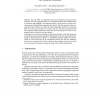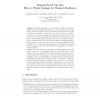48 search results - page 3 / 10 » Computer-Aided Security Proofs for the Working Cryptographer |
ESOP
2005
Springer
15 years 5 months ago
2005
Springer
Since the 1980s, two approaches have been developed for analyzing security protocols. One of the approaches relies on a computational model that considers issues of complexity and ...
101
click to vote
JCP
2010
14 years 10 months ago
2010
Generalized signcryption which proposed by Han is a new cryptographic primitive which can work as an encryption scheme, a signature scheme or a signcryption scheme [5]. However,the...
109
click to vote
IACR
2011
13 years 11 months ago
2011
Abstract. Tampering attacks are cryptanalytic attacks on the implementation of cryptographic algorithms (e.g., smart cards), where an adversary introduces faults with the hope that...
84
Voted
CCS
2008
ACM
15 years 2 months ago
2008
ACM
As cryptographic protocols execute they accumulate information such as values and keys, and evidence of properties about this information. As execution proceeds, new information b...
84
Voted
SCN
2010
Springer
14 years 10 months ago
2010
Springer
In this work, we consider Authentication and Key Agreement (AKA), a popular client-server Key Exchange (KE) protocol, commonly used in wireless standards (e.g., UMTS), and widely c...


